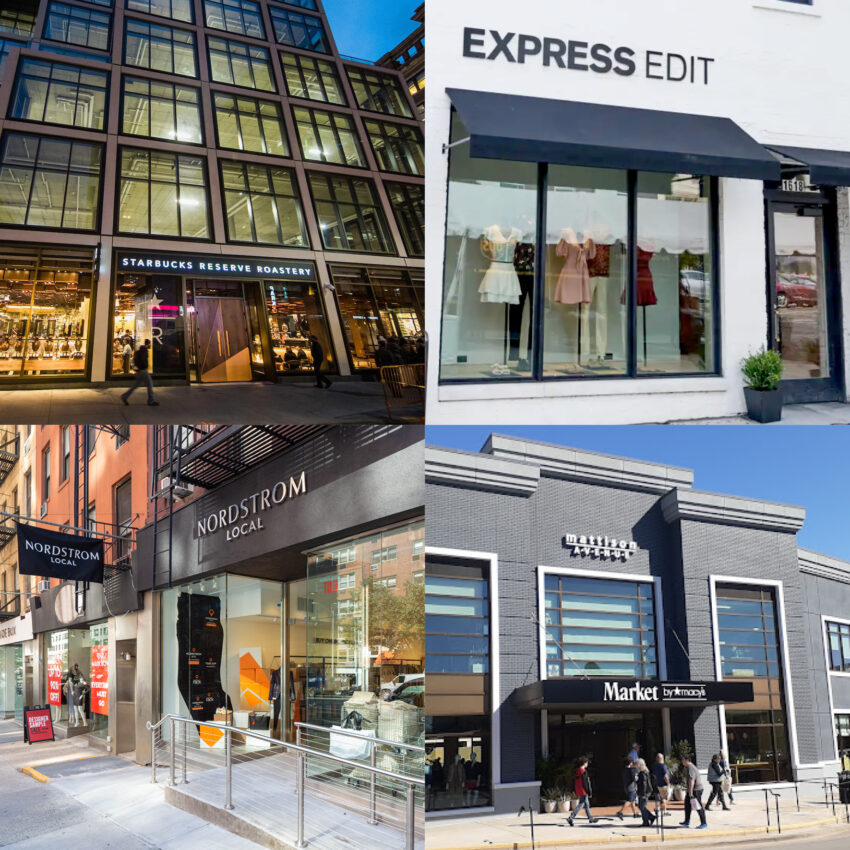Specialty retailers – from legacy brands and DTCs to startups – are all facing the same challenge: Declining mall traffic and higher downtown office vacancy rates are making traditional store location decisions far riskier. Brands are wondering if neighborhood stores are the next frontier. If Target, Macy’s, Starbucks, Faherty, Lululemon, Vineyard Vines and others can do it, why can’t we?
Local Incubators
In fact, neighborhood locations have always played an important role as incubators of new specialty retail concepts. Notable brands, including The Limited, Gap, Anthropologie, and Lululemon all began as neighborhood locals. To grow fast and scale, however, they chose regional malls as their primary channel.
The rationale was that mall stores, with their larger trade areas and “cookie cutter” formulas, were generally more productive and less risky. Neighborhood stores, with their smaller trade areas, had lower revenue potential, didn’t fit the cookie cutter size and assortment models that drove mall store operations. They also often required a different store design due to local architectural standards, odd space configurations and a different customer journey. The mall prototype model did not work for neighborhood stores and vice versa. Traditional wisdom believed there were too few opportunities to be worth the effort required to build a different financial and operating model for small, local stores.
That calculus, however, may be shifting.
Think Local
With 20+ percent of a brand’s revenue now coming from ecommerce, neighborhood stores can play an important role as ship-from, pick-up and return-to depots. Having these services much closer to home adds huge value for customers. It increases in-store visits, which increases conversion. Data confirm that physical stores in a market can improve the brand’s ecommerce sales by 25 percent or more.
And there’s more in favor of local stores. The insights from mobility data and AI can significantly improve the predictability of local site selection, with related improvement in productivity. Merchandise assortments can be matched to neighborhood customers using data analytics. From a practical perspective, the normalization of WFH and hybrid work have created a renaissance in neighborhood store traffic and access to local talent as a workforce that represents the community.
In many markets, the neighborhood center/district can beat the mall on occupancy costs by offsetting the higher capital cost of customized store design. Such local centers can also give the retailer more flexibility on operating hours, reducing labor costs.
Lastly, local stores can bring intensity and intimacy to the brand’s value proposition. They strengthen community bonds and can develop longer-term customer relationships. As part of a unified commerce strategy, going local brings the brand into the neighborhood in a valuable way, increasing customer lifetime value (CLV) and total market profitability.
Location, Location, Location
Strategically, building a fleet of stores has always been the art and science of identifying, on a market-by-market basis, the right number of stores to efficiently serve all potential customers in that market. Physical retail stores are expensive to build and operate, and mistakes are costly. Spacing is important – attractive opportunities may lie in the shadow of more current or future productive locations. Geo-analytics can help optimize markets. The investment against return can be daunting if you get the basics wrong.
Regional shopping centers, as the name implies were developed to reach a broad swath of the [population. There are more than a few markets where shopping center developers literally built centers called Northland, Eastland, Westland, and Southland, explicitly and geographically describing market coverage. But by whatever naming convention, by the mid-1990s the regional mall coverage map was becoming overbuilt.
For the last two decades the regional mall market share has been in a steep decline. Today, roughly half of the once 1,100 regional enclosed mall shopping centers have closed or are the walking dead. Let’s face it, the U.S. has been over-stored for several decades and declining mall locations have more than replaced the growth of outlet centers, big box power centers, specialty, and hybrid lifestyle centers, and by the rebirth of metro neighborhood strip centers and street districts.
While these local locations may not have the trade area draw of the large regional malls they replaced, they may well have a higher concentration of core customers. These are locations that are destinations, not accidental retail. When customers come to a center intentionally, the chances are good that their expectations will be met with purchases that matter.
A Unique Role in the Portfolio
Mature specialty retailers sell across multiple real estate channels — workhorse mall stores, high-street flagships, outlet stores, and online. What role do neighborhood stores play?
Mall stores may continue to dominate for some time, but the neighborhood channel has inherent advantages of its own: convenience, novelty, intimacy, personal connection, and being part of the community. The timing could not be better to play into the hands of local retailers. In a fractious world, consumers value these qualities more than ever.
Here’s a playbook to maximize going local:
- Originality and intimacy of the store environment, including visual merchandising.
- Product displays that are novel and diverse.
- A high level of personal service, combined with full-service, omni-capable tech.
- Engagement with the local community.
Field Reports
There is a P4 formula to getting the big-picture playbook right.
Place
- Create an engaging sub-brand, e.g., Nordstrom Local, Market by Macy’s, Express Edit, Starbuck’s Roastery, etc.
- Embody a warmer, more accessible interior design.
- Make the décor authentic, relevant, and contextual to the neighborhood.
- Revitalize the local area with an infusion of energy and promise.
Product
- Showcase more variety with style/color choices in tune with local customers.
- Create demand through merchandise scarcity rather than inventory depth with lookalike merchandise.
- Focus on the “sizzle” (quickens the pulse) and not so much the “steak” (fulfills a utilitarian need).
- Curate an assortment tailored to the local trade area and maybe sprinkle in local-themed merchandise and local artists/designers/artisans/craftspeople.
- Focus more on services (e.g., sales, styling, alterations, and omni — the Nordstrom Local model)
People and Tech
- Build a staffing model that allows for high-quality, one-on-one service.
- Hire influential local residents with a service orientation and personal connections in the community.
- Make sure the systems delivering omni options are integrated.
- Empower the store manager to act as store owner (P&L), who will:
- Play a direct role in product selection and ordering.
- Lead or direct the store’s visual merchandising.
- Manage the P&L of controllable items.
Projection
- Create robust local social media inviting customers to contribute.
- Advertise to customers in digital and local media.
- Host periodic store events, featuring locals, to draw in local traffic.
- Participate in commercial district/association and events.
- Celebrate employees and local customers with recognition.
- Give back to the community.
Back to Basics
Neighborhood stores can more deeply connect with and “wow” customers, focusing less on product sales within the four walls and more on creating brand converts and loyalists. Think of it as a store where everyone knows your name. Deeply personal, relevant to local lifestyles and interests, and committed to improving the quality of life as a mantra, not a motto.


